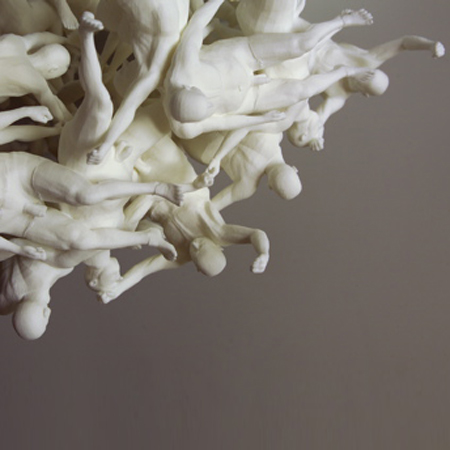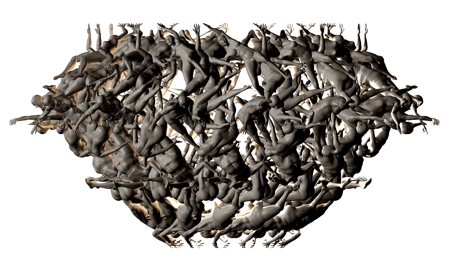
Materialise.MGX in Milan
Live from Milan: rapid prototyping company Materialise.MGX have shown a new collection of work by various designers, including the Damned by Dutch architect Luc Merx of Gagat International.

Consisting of a cluster of writhing human bodies and based on the notion of the fall of the damned, the lamp is made of white selective laser sintered polyamide.
The light is part of Merx's Rococorelevance research project, which explores parallels between contemporary design issues and those of the 18th Century.
More from Materialise.MGX coming soon...
Press details of Merx's Damned lamp below:
--
The Damned Lampshade
Dutch architect Luc Merx’s lampshade is an algorithmic mass of writhing nudes that recalls the classical motif of the fall of the damned. He imagines the lamp hanging above a dining table, the shock of the frozen, terrified bodies disturbing diners with age-old questions of guilt and morality, issues usually kept behind closed doors.
By producing the piece with Materialise’s technology, Merx also has another historical reference in mind: “The lamp is a masterpiece of virtuosity, similar to that of 18th-century ivory furniture," he says. “But the difference is that this is not the result of our virtuosity, but that of a computer."
The lampshade appears as a hovering mass of ornaments, opulent and bombastic. When looked at from closer by it dissolves into single bodies, which are twisted in fear and seem to be frozen in falling.
Their rhythmic order becomes slightly perplexing and finally renders the bodies an ornament. Softly, like the fleshy parts of the bodies, legs and stomachs are reflecting the light. Because of the shadows the bodies cast on themselves, only parts of them appear in the foreground.
Only Fragments of the lit inner part of the lamp are distinguishable. The aspects of the lit core are changing strongly whenever the observer changes his position. These movements of the observer transform the stiff bodies into dynamic objects.
The association with the fall of the damned, a metaphor for guilt and punishment gives the lamp a certain amount of ambivalence: is it a moralistic message, an act of formalism or both?
The Damned Lampshade is one of the works in which Gagat international reactivates historic imagery as a reference for their designs. The design of this lamp undermines several taboos imposed on design in the 20th century: it is figurative, ornamental, and narrative.
The new questions about the possibilities of forms posed by this originate in a new understanding of technology. Technology no longer generates the forces, which determine the design of goods, but it enables an incredible range of possibilities and thus creates a new freedom of form.
Our answer to this new freedom is not the voluntary self-restriction usually applied in modern design. Instead we choose to roam freely in the myriads of possibilities given to us. Seen in this way design reflects the situation of the designer himself.
Rococorelevance
Rococorelevance is a research project, which deals with the parallels between contemporary tendencies in architectural design and those of the 18th century.
With Rococorelevance we are trying to develop history in a new manner and use it as an architectural reference. The project rejects the naive faith in the progress of the avantgarde, but also disapproves of retro-tendencies.
Rococorelevance criticises the market conformity, which is hidden behind the simplified and superficial quoting from architecture of the past.
The projects are a result of various cooperations between Gagat international, TU Kaiserslautern, Stefan Rinnebach, Torsten Bodschwinna, Holmer Schleyerbach, the architecture critic Christian Holl, and others.
Rococorelevance has been initiated by Luc Merx, who also designed The Damned Lampshade.
Text: Chistian Holl + Luc Merx
Design Damned Lampshade: Gagat international, Luc Merx
--

Dezeen's live coverage of Milan 2007 is brought to you in conjunction with the International Design Forum. Visit our IDF blog here.